Top Rankings
Hawthorne-Cedar Knolls Union Free School District ranks among the top 20% of public school district in New York for:
Category
Attribute
Diversity
Most diverse schools (Top 1%)
Student Attention
Lowest student:teacher ratio (Top 1%)
For the 2025 school year, there are 2 public schools serving 114 students in Hawthorne-Cedar Knolls Union Free School District.
Public Schools in Hawthorne-Cedar Knolls Union Free School District have a diversity score of 0.65, which is less than the New York public school average of 0.72.
Minority enrollment is 90% of the student body (majority Black), which is more than the New York public school average of 60% (majority Hispanic).
Overview
This School District
This State (NY)
# Schools
2 Schools
4,818 Schools
# Students
114 Students
2,508,712 Students
# Teachers
24 Teachers
217,359 Teachers
Student : Teacher Ratio
5:1
5:1
District Rank
The school district's graduation rate of 50% has increased from 20% over five school years.
Math Test Scores (% Proficient)
(20-21)<50%
55%
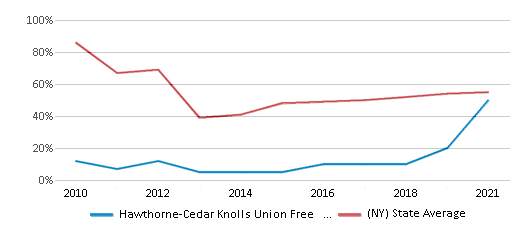
Reading/Language Arts Test Scores (% Proficient)
(20-21)<50%
62%

Graduation Rate
<50%
87%
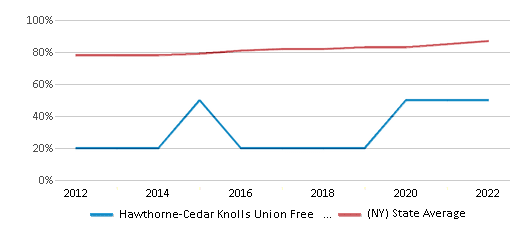
Students by Ethnicity:
Diversity Score
0.65
0.72
# American Indian Students
1 Student
18,867 Students
% American Indian Students
1%
1%
# Asian Students
2 Students
254,462 Students
% Asian Students
2%
10%
# Hispanic Students
44 Students
757,452 Students
% Hispanic Students
38%
30%
# Black Students
50 Students
389,125 Students
% Black Students
44%
16%
# White Students
11 Students
995,067 Students
% White Students
10%
40%
# Hawaiian Students
n/a
5,556 Students
% Hawaiian Students
n/a
n/a
# Two or more races Students
6 Students
87,601 Students
% of Two or more races Students
5%
3%
Students by Grade:
# Students in PK Grade:
-
62,556
# Students in K Grade:
-
171,540
# Students in 1st Grade:
1
177,074
# Students in 2nd Grade:
1
181,096
# Students in 3rd Grade:
1
177,104
# Students in 4th Grade:
4
180,516
# Students in 5th Grade:
9
181,163
# Students in 6th Grade:
6
184,038
# Students in 7th Grade:
11
185,375
# Students in 8th Grade:
9
188,665
# Students in 9th Grade:
11
205,039
# Students in 10th Grade:
20
201,456
# Students in 11th Grade:
5
191,213
# Students in 12th Grade:
34
185,905
# Ungraded Students:
2
35,972
District Revenue and Spending
The revenue/student of $131,965 is higher than the state median of $31,307. The school district revenue/student has grown by 63% over four school years.
The school district's spending/student of $145,070 is higher than the state median of $32,183. The school district spending/student has grown by 63% over four school years.
Total Revenue
$15 MM
$78,541 MM
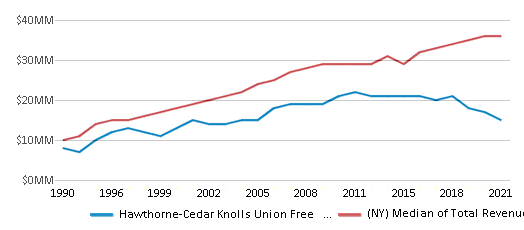
Spending
$17 MM
$80,737 MM
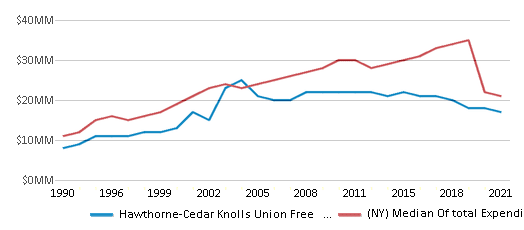
Revenue / Student
$131,965
$31,307
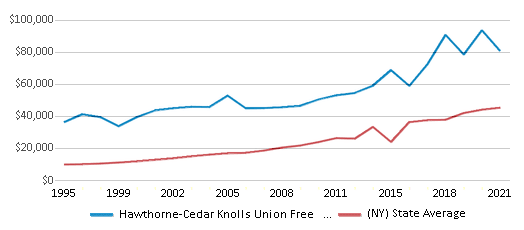
Spending / Student
$145,070
$32,183
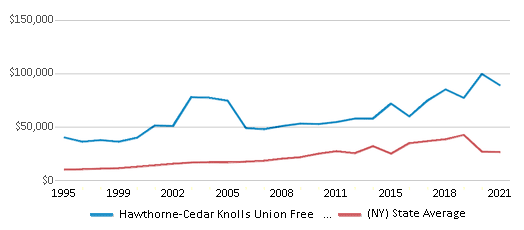
Best Hawthorne-Cedar Knolls Union Free School District Public Schools (2025)
School
(Math and Reading Proficiency)
(Math and Reading Proficiency)
Location
Grades
Students
Rank: #11.
Cedar Knolls Academy
Special Education School
(Math: <50% | Reading: <50% )
Rank:
Rank:
5/
Bottom 50%10
226 Linda Ave
Hawthorne, NY 10532
(914) 749-2964
Hawthorne, NY 10532
(914) 749-2964
Grades: K-12
| 66 students
Rank: #22.
Linden Hill High School
Special Education School
(Math: ≤20% | Reading: ≤20% )
Rank:
Rank:
1/
Bottom 50%10
226 Linda Ave
Hawthorne, NY 10532
(914) 749-2977
Hawthorne, NY 10532
(914) 749-2977
Grades: 6-12
| 48 students
Frequently Asked Questions
How many schools belong to Hawthorne-Cedar Knolls Union Free School District?
Hawthorne-Cedar Knolls Union Free School District manages 2 public schools serving 114 students.
What is the racial composition of students in Hawthorne-Cedar Knolls Union Free School District?
44% of Hawthorne-Cedar Knolls Union Free School District students are Black, 38% of students are Hispanic, 10% of students are White, 5% of students are Two or more races, 2% of students are Asian, and 1% of students are American Indian.
What is the student/teacher ratio of Hawthorne-Cedar Knolls Union Free School District?
Hawthorne-Cedar Knolls Union Free School District has a student/teacher ratio of 5:1, which is lower than the New York state average of 11:1.
What is Hawthorne-Cedar Knolls Union Free School District's spending/student ratio?
The school district's spending/student of $145,070 is higher than the state median of $32,183. The school district spending/student has grown by 63% over four school years.
Recent Articles

What Is A Charter School?
Explore the world of charter schools in this comprehensive guide. Learn about their history, how they operate, and the pros and cons of this educational innovation. Discover key facts about charter schools, including admission policies, demographics, and funding, as well as what to look for when considering a charter school for your child.

10 Reasons Why High School Sports Benefit Students
Discover the 10 compelling reasons why high school sports are beneficial for students. This comprehensive article explores how athletics enhance academic performance, foster personal growth, and develop crucial life skills. From improved fitness and time management to leadership development and community representation, learn why participating in high school sports can be a game-changer for students' overall success and well-being.

February 05, 2025
Understanding the U.S. Department of Education: Structure, Impact, and EvolutionWe explore how the Department of Education shapes American education, from its cabinet-level leadership to its impact on millions of students, written for general audiences seeking clarity on this vital institution.





